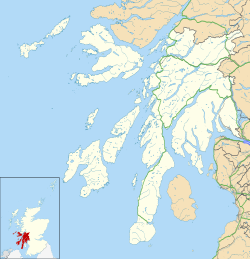Balvicar
| |
|---|---|
Location within Argyll and Bute | |
| Population | 112 [1] |
| Language | English Scottish Gaelic |
| OS grid reference | NM7617 |
| • Edinburgh | 95 mi (153 km) ESE |
| • London | 400 mi (640 km) SE |
| Council area | |
| Lieutenancy area | |
| Country | Scotland |
| Sovereign state | United Kingdom |
| Post town | OBAN |
| Postcode district | PA34 |
| Dialling code | 01852 |
| UK Parliament | |
| Scottish Parliament | |
Balvicar (Scottish Gaelic : Baile a' Bhiocair) is a village on the island of Seil, a small island seven miles (eleven kilometres) southwest of Oban, Scotland. It is one of three villages on the island along with Ellenabeich and Clachan-Seil. It was a former slate-mining village beginning in the 16th century, and eventually ceased mining after sporadic operation between the 1940s and 60s. [2]
Balvicar contains a shop [3] which also serves as a post office. The Isle of Seil Golf Club is also situated in the village. There is a fish factory which processes locally caught langoustines that go for export, and a number of creel fishing boats operate out of Balvicar Bay. There is a boatyard which offers repairs and maintenance for both fishing and pleasure vessels plus winter storage for yachts and small commercial vessels.
As of 2001 [update] , 2.68% of people in Balvicar could speak Scottish Gaelic. [1]


